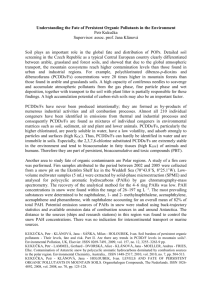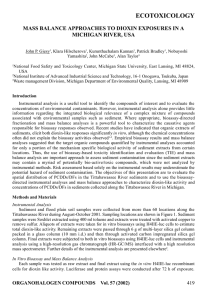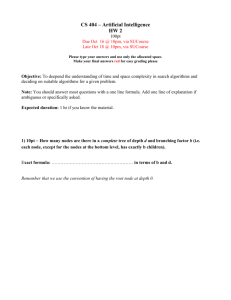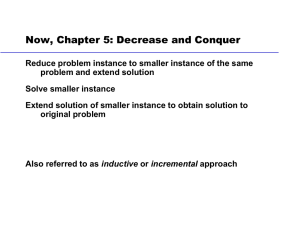Concentrations and accumulation profiles of polychlorinated
advertisement
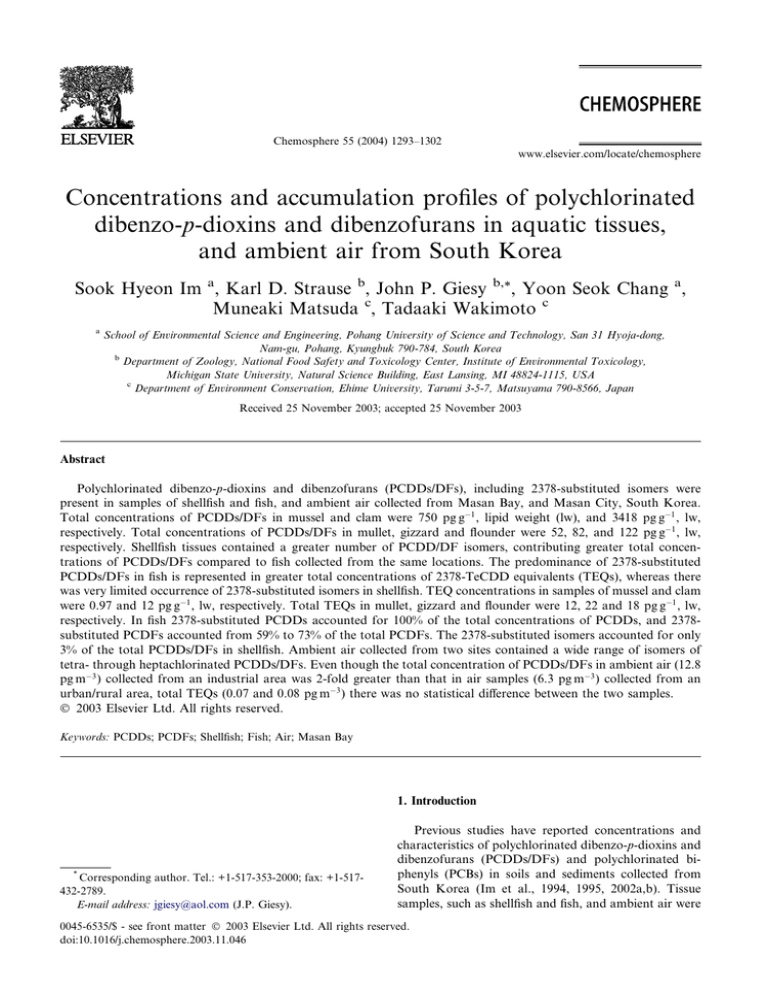
Chemosphere 55 (2004) 1293–1302 www.elsevier.com/locate/chemosphere Concentrations and accumulation profiles of polychlorinated dibenzo-p-dioxins and dibenzofurans in aquatic tissues, and ambient air from South Korea Sook Hyeon Im a, Karl D. Strause b, John P. Giesy b,*, Yoon Seok Chang a, Muneaki Matsuda c, Tadaaki Wakimoto c a School of Environmental Science and Engineering, Pohang University of Science and Technology, San 31 Hyoja-dong, Nam-gu, Pohang, Kyungbuk 790-784, South Korea b Department of Zoology, National Food Safety and Toxicology Center, Institute of Environmental Toxicology, Michigan State University, Natural Science Building, East Lansing, MI 48824-1115, USA c Department of Environment Conservation, Ehime University, Tarumi 3-5-7, Matsuyama 790-8566, Japan Received 25 November 2003; accepted 25 November 2003 Abstract Polychlorinated dibenzo-p-dioxins and dibenzofurans (PCDDs/DFs), including 2378-substituted isomers were present in samples of shellfish and fish, and ambient air collected from Masan Bay, and Masan City, South Korea. Total concentrations of PCDDs/DFs in mussel and clam were 750 pg g1 , lipid weight (lw), and 3418 pg g1 , lw, respectively. Total concentrations of PCDDs/DFs in mullet, gizzard and flounder were 52, 82, and 122 pg g1 , lw, respectively. Shellfish tissues contained a greater number of PCDD/DF isomers, contributing greater total concentrations of PCDDs/DFs compared to fish collected from the same locations. The predominance of 2378-substituted PCDDs/DFs in fish is represented in greater total concentrations of 2378-TeCDD equivalents (TEQs), whereas there was very limited occurrence of 2378-substituted isomers in shellfish. TEQ concentrations in samples of mussel and clam were 0.97 and 12 pg g1 , lw, respectively. Total TEQs in mullet, gizzard and flounder were 12, 22 and 18 pg g1 , lw, respectively. In fish 2378-substituted PCDDs accounted for 100% of the total concentrations of PCDDs, and 2378substituted PCDFs accounted from 59% to 73% of the total PCDFs. The 2378-substituted isomers accounted for only 3% of the total PCDDs/DFs in shellfish. Ambient air collected from two sites contained a wide range of isomers of tetra- through heptachlorinated PCDDs/DFs. Even though the total concentration of PCDDs/DFs in ambient air (12.8 pg m3 ) collected from an industrial area was 2-fold greater than that in air samples (6.3 pg m3 ) collected from an urban/rural area, total TEQs (0.07 and 0.08 pg m3 ) there was no statistical difference between the two samples. Ó 2003 Elsevier Ltd. All rights reserved. Keywords: PCDDs; PCDFs; Shellfish; Fish; Air; Masan Bay 1. Introduction * Corresponding author. Tel.: +1-517-353-2000; fax: +1-517432-2789. E-mail address: jgiesy@aol.com (J.P. Giesy). Previous studies have reported concentrations and characteristics of polychlorinated dibenzo-p-dioxins and dibenzofurans (PCDDs/DFs) and polychlorinated biphenyls (PCBs) in soils and sediments collected from South Korea (Im et al., 1994, 1995, 2002a,b). Tissue samples, such as shellfish and fish, and ambient air were 0045-6535/$ - see front matter Ó 2003 Elsevier Ltd. All rights reserved. doi:10.1016/j.chemosphere.2003.11.046 1294 S.H. Im et al. / Chemosphere 55 (2004) 1293–1302 Samples of shellfish (mussel and clam) and fish (mullet, gizzard and flounder) and ambient air were collected from Masan Bay and Masan City, South Korea (Fig. 1). Masan Bay is a semi-closed estuary, in southeastern South Korea that has productive fishing areas in the near the open sea. About 150 samples of the mussel (Septifer virgatus) and clam (Anomalocardia sp.) were collected respectively in May 1993. Five samples of gizzard (Konosirus punctatus) and 23 flounder (Cleisthenes pinetorum herzensteini) were collected in December 2 Changwon City an 2. Materials and methods Masan City Mas collected concurrently for this study. Shellfish and fish samples often used to monitor for environmental contaminants that bioaccumulate and have the potential to adversely affect aquatic organisms and wildlife, and to evaluate potential risk of PCDDs/DFs to people who eat them (Giesy et al., 1994). However, very limited information was available on the isomer distribution of PCDDs/DFs and bioaccumulative characteristics in aquatic trophic levels, such as shellfish and fish, in South Korea. Ambient air is useful for monitoring of terrestrial environment of PCDDs/DFs. Once distributed to ambient air, organohalogen compounds, such as PCDDs/DFs, are easily transported from sites with sources to long distance locations, deposited and accumulated into various environmental media, such as vegetation, soils, grazing livestock and human diet and human exposure (Kevin and Duarte-Davidson, 1997; Lohmann et al., 1999). PCDDs/DFs are released into the environment from many possible sources including incineration, industrial processes, and internal combustion engines. PCDDs/ DFs have been identified as agents responsible for many toxic responses in exposed individuals, including cancer and developmental/reproductive dysfunctions (Murray et al., 1979; Peterson et al., 1993; Aylward et al., 1996). Because of their stable structure and lipophilic properties, PCDDs/DFs have been the focus of many environmental and toxicological studies over the last several years, and these chemicals have been identified in diverse environmental samples from a range of countries (Gardner and White, 1990; Eitzer, 1993; Kucklick and Baker, 1998; Giesy et al., 1999). A previous study reported concentrations of PCDDs/DFs of dairy products from 39 countries, among which samples from Korea contained the greatest total concentrations (Weiss et al., 2001). The objectives of this research were to identify distributions of PCDDs/DFs in samples of shellfish, fish and ambient air collected from South Korea, including estimations of 2378-tetrachlorinated dibenzo-p-dioxin (2378-TeCDD) equivalents (TEQs), and to characterize accumulative and exposure properties of PCDDs/DFs between trophic levels such as shellfish and fish. 1 Ba y KOREA Study area Fig. 1. Map of Masan Bay and Masan City, South Korea, indicating sampling locations for shellfish and fish, and air. Tissues were collected from the bay, and ambient samples were collected from two sites (( ) sites 1 and 2) in the city. 1993, and three Mullet (Liza macrolepis) samples were collected in November 1991. Mussel and clam samples were collected by hand from near-shore habitats. All shellfish samples were processed into whole-body minus shell edible portions. Fish samples were collected via hook-and-line (sport fishing) and gill netting (census) methods. Ranges of the size of fish were: mullet (20–30 cm), gizzard (10–16 cm), and flounder (12–16 cm). Fish samples were prepared as skin-on fillets from which scales and bones had been removed. Each sample was rinsed with purified water to remove all foreign particles, wrapped with clean aluminum foil, and stored at )20 °C until analyzed. To increase the mass of fat available for extraction, all fillet and mussel tissue samples within a given species a single pooled sample composite was made. Pooled sample weights for mussel, clam, mullet, gizzard and flounder were 643, 401, 230, 145, and 483 g, respectively. Wet tissue was homogenized with anhydrous sodium sulfate, and Soxhlet extracted with acetone (6 h) and dichloromethane (24 h) to extract lipid and associated PCDDs/DFs. The lipid-fractions of the tissues were: 1.9%, 1.3%, 2.7%, 2.4% and 2.1% for mussel, clam, mullet, gizzard and flounder, respectively. PCDDs/DFs analyses were completed on each respective lipid fraction. Known amounts of 13 C-labeled S.H. Im et al. / Chemosphere 55 (2004) 1293–1302 PCDDs/DFs were added to samples as internal standards. The extract containing the lipids and PCDDs/ DFs were transferred to hexane and treated with concentrated sulfuric acid, followed by a series of silica gel, alumina, activated carbon, and Sep-pak columns to purify and separate the PCDDs/DFs from possible interfering compounds (Im et al., 1995). Ambient air was collected from two sites in Masan City during March 1995 (sites 1 and 2, Fig. 1). Initial air sampling activities included four collection sites, however two of the four samples were lost during sampling, and data from the two sites are discussed here. Site 1 was located in an industrial area where local conditions are influenced by industrial activities, such as metal processing and waste incineration. Site 2 was on the roof of a building in an urban/rural area. Air samples were taken continuously for 5 days with a flow rate of approximately 18 m3 /h. An air pump sampler (model AP-240Z, Iwaki Co., Japan) equipped with cleaned glass fiber filters and three polyurethane foam plugs (PUF; diameter, 4 cm; length, 5 cm) was used to capture PCDDs/DFs associated with particulate matter and the gaseous phase. Air flow rate was measured with a gaseous flow meter (model RK-1450-002, Koshima Co., Japan). Following sample collection, the filters and PUF plugs were Soxhlet extracted with 500 ml acetone for 6 h followed by 500 ml toluene for 24 h. Known amounts of 13 C-labeled PCDDs/DFs were added to samples as internal standards. After Kuderna-Danish concentration, the solvent was transferred to hexane and treated with concentrated sulfuric acid. A series of silica gel, alumina, activated carbon, and Sep-pak column clean-up procedures were completed. PCDDs/DFs were identified and quantified using a high-resolution gas chromatograph interfaced with a high-resolution mass spectrometer (HRGC-HRMS). Instrumentation included a Hewlett Packard (HP) 5890 series II gas chromatograph (Avondale, PA, USA), connected to a JEOL SX102A high-resolution mass spectrometer. The capillary column was 50 m long with a 0.25-mm i.d. and 0.2-lm stationary phase film thickness (CP-Sil 88, Chromopack, Supelco, Bellefonte, PA, USA). The mass spectrometer was operated in EI mode at 70 eV. PCDDs/DFs were determined by selected ion monitoring (SIM) at the two most intensive ions of the molecular ion cluster. Recoveries of 13 C-labeled internal standards ranged from 83% to 105%. Reported concentrations were corrected for the recoveries of internal standards. Identification and quantification of PCDDs/ DFs were performed by means of internal and external standards. A fly ash sample containing known compositions of PCDD/DF isomers was used as a reference to identify individual PCDDs/DFs. Procedural blanks were analyzed for every five samples to check for interferences and laboratory contamination. Interferences were not found in blanks. Concentrations of PCDDs/DFs are 1295 reported as the sum of all the quantifiable isomers. Concentrations that were less than the method detection limits (MDL) were assigned a value of zero when calculating means. Total TEQ concentrations are calculated for the 17 2378-substituted PCDDs/DFs using international toxic equivalency factors (I-TEFs) (Kutz et al., 1990). 3. Results and discussion 3.1. Shellfish and fish From the individual isomers of tetra- through octachlorinated PCDDs/DFs detected, total concentrations of PCDDs/PCDFs, and TEQs were calculated, and given on both a lipid-weight and wet-weight basis (Table 1). Total concentrations of PCDDs/DFs in shellfish tissues, such as mussel and clam were 750 and 3418 pg g1 , lw, respectively, and those of mullet, gizzard and flounder were 52, 82 and 122 pg g1 , lw, respectively. Shellfish tissues contained a wide range of PCDD/DF isomers, affecting greater PCDD/DF concentrations, than did fish, and mean concentrations were 25-fold greater than those in fish. Chromatograms of all the tetra- through octachlorinated PCDD/DF isomers detected in clam samples are shown (Fig. 2). Among PCDD/DF isomers, 2378-substituted PCDDs/ DFs are more toxic and persistent than the other isomers of PCDDs/DFs, and can interact with the aromatic hydrocarbon receptor (AhR). Total concentrations of 2378-TeCDD equivalents (TEQs) in samples of mussel and clam were 0.97 and 12 pg g1 , lw, respectively. Total TEQs in mullet, gizzard and flounder were 12, 22 and 18 pg g1 , lw, respectively. Although the total concentrations of PCDDs/DFs in fish were much less than those in shellfish, 2378-substituted were the predominant isomers in fish, affecting great TEQs (Table 1). In fish 2378substituted PCDD isomers accounted for 100% of the total PCDD concentrations, and the 2378-substituted PCDF accounted for from 59% of the total PCDFs in flounder to 73% in mullet, whereas the 2378-substituted isomers accounted for only 3% of the total PCDDs/DFs in shellfish. The limited presence of 2378-substituted isomers in shellfish resulted in small concentrations of TEQs. These results indicate that 2378-substituted isomers are more likely to be stable and retained in fish tissues, and less biodegradation of a range of PCDD/DF isomers occurred in shellfish. These findings are similar to those observed in shellfish and fish tissues in other relevant studies (Naito et al., 2003). Total TEQs, expressed on a wet weight basis, in fish collected from Masan Bay ranging from 0.32 to 0.53 pg g1 , ww (Table 1), were similar or slightly less than those reported in other comparable studies. Total TEQs in fish from Tokyo Bay (Sakurai et al., 2000), and Lake Kasumigaura, Japan 1296 S.H. Im et al. / Chemosphere 55 (2004) 1293–1302 Table 1 Total PCDDs/DFs and TEQs in shellfish and fish (pg g1 ), and in air (pg m3 ) from Masan Bay and Masan City PCDDs/DFs Shellfish Fish Air Mussel Clam Mullet Gizzard 247 75 8.5 17 2.1 <0.02 <0.02 <0.02 15 2.1 <0.02 <0.02 <0.02 <0.02 15 381 1196 417 <0.02 51 36 <0.02 <0.02 24 51 <0.02 <0.02 <0.02 <0.02 <0.02 <0.02 1774 <0.02 <0.02 <0.02 <0.02 <0.02 <0.02 <0.02 <0.02 <0.02 <0.02 <0.02 <0.02 <0.02 <0.02 <0.02 <0.02 <0.02 <0.02 <0.02 <0.02 <0.02 <0.02 7.6 <0.02 <0.02 <0.02 <0.02 <0.02 <0.02 <0.02 <0.02 7.6 PeCDDb 12479 + 12468 12368 12478 12379 12469 + 12347 12378 12369 12467 12489 12346 12367 12389 Total 18 6.8 <0.02 <0.02 <0.02 <0.02 <0.02 <0.02 <0.02 <0.02 <0.02 <0.02 25 76 40 <0.02 13 6.6 <0.02 <0.02 <0.02 <0.02 <0.02 <0.02 <0.02 135 <0.02 <0.02 <0.02 <0.02 <0.02 4.6 <0.02 <0.02 <0.02 <0.02 <0.02 <0.02 4.6 HeCDDc 124679 + 124689 + 123468 123679 + 123689 123478 123678 123469 123789 123467 Total <0.02 <0.02 <0.02 <0.02 <0.02 <0.02 <0.02 <0.02 26 5 <0.02 <0.02 <0.02 <0.02 <0.02 31 HpCDDd 1234679 1234678 Total 9.8 <0.02 9.8 OCDDe 12346789 15 TeCDDa 1368 1379 1378 1247 + 1248 + 1369 1268 1478 2378 1234 + 1246 + 1249 1237 + 1238 1279 + 1236 1469 + 1278 1239 1269 1267 1289 Total Flounder Site 1 Site 2 <0.02 <0.02 <0.02 <0.02 <0.02 <0.02 4.3 <0.02 <0.02 <0.02 <0.02 <0.02 <0.02 <0.02 <0.02 4.3 2.56 1.1 0.17 0.05 <0.02 <0.02 0.03 0.24 <0.02 <0.02 0.05 <0.02 <0.02 <0.02 0.03 4.2 0.89 0.32 0.2 <0.02 <0.02 <0.02 0.05 <0.02 <0.02 <0.02 <0.02 <0.02 <0.02 <0.02 <0.02 1.5 <0.02 <0.02 <0.02 <0.02 <0.02 5.9 <0.02 <0.02 <0.02 <0.02 <0.02 <0.02 5.9 <0.02 <0.02 <0.02 <0.02 <0.02 <0.02 <0.02 <0.02 <0.02 <0.02 <0.02 <0.02 <0.02 0.6 0.2 <0.02 0.1 0.03 <0.02 <0.02 <0.02 <0.02 <0.02 <0.02 <0.02 0.89 0.2 0.07 <0.02 0.05 0.02 <0.02 <0.02 <0.02 <0.02 <0.02 <0.02 <0.02 0.33 <0.02 <0.02 <0.02 <0.02 <0.02 <0.02 <0.02 <0.02 <0.02 <0.02 <0.02 <0.02 <0.02 <0.02 <0.02 <0.02 <0.02 <0.02 <0.02 <0.02 <0.02 <0.02 <0.02 <0.02 0.32 0.14 <0.02 <0.02 <0.02 <0.02 <0.02 0.46 0.19 0.1 <0.02 0.05 <0.02 <0.02 <0.02 0.34 7.4 30 37 <0.02 <0.02 <0.02 <0.02 <0.02 <0.02 <0.02 <0.02 <0.02 0.16 0.24 0.4 0.08 0.13 0.21 <0.02 9.3 <0.02 <0.02 <0.02 <0.02 <0.02 86 47 12 111 22 <0.02 <0.02 <0.02 <0.02 <0.02 <0.02 <0.02 <0.02 <0.02 <0.02 <0.02 <0.02 <0.02 <0.02 <0.02 <0.02 <0.02 <0.02 0.19 0.22 0.26 0.18 0.14 0.23 0.1 0.13 0.16 0.08 0.07 0.13 f TeCDF 1368 1378 + 1379 1347 1468 1247 + 1367 1348 <0.02 26 9.6 14 19 7.7 S.H. Im et al. / Chemosphere 55 (2004) 1293–1302 1297 Table 1 (continued) PCDDs/DFs 1346 + 1248 1237 + 1369 + 1478 + 1246 + 1268 1234 + 1678 1238 + 1467 + 1236 + 2468 1349 1278 1267 + 1279 1469 + 2368 + 1249 2467 1239 + 2347 1269 2378 2348 2346 2367 3467 1289 Total Shellfish Fish Air Mussel Clam Mullet Gizzard 9.6 42 69 215 1.1 <0.02 <0.02 <0.02 Flounder Site 1 Site 2 <0.02 <0.02 0.09 0.67 0.1 0.42 12 17 16 9.6 13 19 19 8.8 <0.02 9.6 9.6 9 19 5.8 <0.02 295 52 85 76 50 36 85 66 50 2.5 61 59 26 97 33 <0.02 1337 <0.02 <0.02 <0.02 <0.02 <0.02 <0.02 <0.02 <0.02 <0.02 9.2 9.2 <0.02 <0.02 <0.02 <0.02 20 <0.02 <0.02 <0.02 <0.02 <0.02 <0.02 <0.02 <0.02 <0.02 24 21 <0.02 <0.02 <0.02 <0.02 45 <0.02 <0.02 <0.02 <0.02 <0.02 <0.02 <0.02 <0.02 <0.02 45 43 <0.02 <0.02 <0.02 <0.02 88 0.11 0.52 <0.02 <0.02 <0.02 0.33 0.44 0.09 <0.02 0.08 0.1 0.16 0.13 0.09 <0.02 4.0 0.57 0.19 <0.02 <0.02 <0.02 <0.02 0.1 0.06 <0.02 0.04 0.09 0.1 <0.02 0.07 <0.02 2.4 PeCDF g 13468 12468 13678 13478 13479 + 12368 12478 12479 + 13467 12467 12347 + 14678 13469 12378 + 12348 12346 + 12379 12367 12469 + 23468 13489 12369 12678 12349 12489 23478 12389 23467 Total 3 12 2.8 <0.02 4.9 <0.02 1.9 <0.02 <0.02 <0.02 <0.02 <0.02 <0.02 <0.02 <0.02 <0.02 <0.02 <0.02 <0.02 <0.02 <0.02 <0.02 24 <0.02 <0.02 4.5 <0.02 21 9 12 12 6 <0.02 9 <0.02 <0.02 <0.02 <0.02 <0.02 6.2 <0.02 <0.02 9.3 <0.02 9 98 <0.02 <0.02 <0.02 <0.02 <0.02 <0.02 <0.02 <0.02 <0.02 <0.02 <0.02 <0.02 <0.02 <0.02 <0.02 <0.02 <0.02 <0.02 <0.02 17 <0.02 <0.02 17 <0.02 <0.02 <0.02 <0.02 <0.02 <0.02 <0.02 <0.02 <0.02 <0.02 4.9 <0.02 <0.02 <0.02 <0.02 <0.02 <0.02 <0.02 <0.02 18 <0.02 <0.02 23 <0.02 <0.02 <0.02 <0.02 5.4 <0.02 <0.02 <0.02 <0.02 <0.02 6.7 <0.02 <0.02 <0.02 <0.02 <0.02 <0.02 <0.02 <0.02 18 <0.02 <0.02 30 0.08 0.1 0.05 <0.02 0.17 0.09 0.07 0.06 0.04 0.04 0.11 <0.02 <0.02 0.08 0.13 <0.02 <0.02 <0.02 <0.02 <0.02 0.08 0.13 1.2 0.08 0.08 0.04 <0.02 0.07 0.03 0.06 0.05 0.02 <0.02 0.06 0.03 <0.02 0.03 0.07 <0.02 <0.02 <0.02 <0.02 <0.02 0.06 0.07 0.8 HeCDF h 123468 124678 + 134679 134678 124679 123478 + 123479 123678 124689 123467 123679 123469 + 123689 123789 <0.02 <0.02 <0.02 <0.02 <0.02 <0.02 <0.02 <0.02 <0.02 <0.02 <0.02 <0.02 <0.02 <0.02 <0.02 3.1 3.1 <0.02 <0.02 <0.02 <0.02 <0.02 <0.02 <0.02 <0.02 <0.02 <0.02 <0.02 <0.02 <0.02 <0.02 <0.02 <0.02 <0.02 <0.02 <0.02 <0.02 <0.02 <0.02 <0.02 <0.02 <0.02 <0.02 <0.02 <0.02 <0.02 <0.02 <0.02 <0.02 <0.02 <0.02 <0.02 <0.02 <0.02 <0.02 0.12 0.23 0.23 0.02 0.02 0.08 0.12 <0.02 0.18 <0.02 <0.02 (continued 0.04 0.09 <0.02 0.11 <0.02 0.06 0.06 <0.02 0.18 <0.02 <0.02 on next page) 1298 S.H. Im et al. / Chemosphere 55 (2004) 1293–1302 Table 1 (continued) PCDDs/DFs Shellfish Mussel Fish Clam Air Mullet Gizzard Flounder Site 1 Site 2 123489 234678 Total <0.02 <0.02 <0.02 <0.02 <0.02 6.2 <0.02 1.4 1.4 <0.02 <0.02 <0.02 <0.02 <0.02 <0.02 <0.02 0.11 1.1 <0.02 0.09 0.6 HpCDF i 1234678 1234679 1234689 1234789 Total <0.02 <0.02 <0.02 <0.02 <0.02 <0.02 <0.02 <0.02 <0.02 <0.02 <0.02 <0.02 <0.02 <0.02 <0.02 <0.02 <0.02 <0.02 <0.02 <0.02 <0.02 <0.02 <0.02 <0.02 <0.02 0.45 0.06 <0.02 <0.02 0.5 0.13 <0.02 <0.02 <0.02 0.1 OCDF j 12346789 <0.02 <0.02 <0.02 <0.02 <0.02 <0.02 <0.02 Lipid weight basis (pg g1 ) Total PCDDs Total PCDFs Total PCDDs + PCDFs TEQs k 431 319 750 0.97 1977 1441 3418 12 (pg m3 ) 14 38 52 12 14 68 82 22 4.3 118 122 18 6 6.8 12.8 0.07 2.4 3.9 6.3 0.08 Wet weight basis (pg g1 ) Total PCDDs Total PCDFs Total PCDDs + PCDFs TEQs 8.2 6.1 14 0.02 26 19 44 0.16 0.38 1 1.4 0.32 0.34 1.6 2 0.53 0.09 2.5 2.5 0.38 a TeCDD ¼ Tetrachlorinated dibenzo-p-dioxin. PeCDD ¼ Pentachlorinated dibenzo-p-dioxin. c HeCDD ¼ Hexachlorinated dibenzo-p-dioxin. d HpCDD ¼ Heptachlorinated dibenzo-p-dioxin. e OCDD ¼ Octachlorinated dibenzo-p-dioxin. f TeCDF ¼ Tetrachlorinated dibenzofuran. g PeCDF ¼ Pentachlorinated dibenzofuran. h HeCDDF ¼ Hexachlorinated dibenzofuran. i HpCDF ¼ Heptachlorinated dibenzofuran. j OCDF ¼ Octachlorinated dibenzofuran. k TEQs ¼ Toxic equivalency quotients. b (Sakurai et al., 1996) ranged from 0.32 to 2.1 pg g1 , ww, and 0.4–2.6 pg g1 , ww, respectively. Total TEQs in fish from the Sacramento-San Joaquin River in the USA ranged from 0.96 to 3.5 pg g1 , ww (Petreas et al., 1992). Distributions of relative concentrations of PCDDs/ DFs and the isomer profiles may be explained by trophic level as well as the duration, extent of exposure and potential for metabolism. Although total PCDDs/DFs, including TEQs, varied considerably among tissue samples, a positive relationship was observed between the trophic position (shellfish vs. fish) and the concentrations/accumulation profiles of PCDDs/DFs. More individual PCDDs/DFs occurred at quantifiable concentrations in shellfish tissues of mussel and clam. The isomers that were observed most frequently and at the greatest concentrations included non-2378-substituted PCDDs/DFs, contributing roughly 97% of the total PCDDs/DFs. 1368- and 1379-TeCDD are the most dominant isomers, contributing 85% and 91% of the TeCDD concentrations in mussel and clam tissue, respectively, which findings are consistent with the results of earlier study on sediment samples (Im et al., 2002b), suggesting that the herbicide CNP which contains these isomer pair as major impurities, could have been the possible source of these isomer (Yamagishi et al., 1981). Total concentrations of PCDDs in shellfish were slightly greater than PCDFs, PCDDs/PCDFs ¼ 1.35 and 1.37 in mussel and clam, respectively. Less chlorinated PCDDs/DFs, in particular, tetrachlorinated dibenzo-p-dioxin/furan (TeCDD/DF) predominated in shellfish tissues. TeCDD/DF alone accounted for greater than 90% of the total PCDDs/DFs in mussel. Similarly, TeCDD/DF accounted for 91% of the total in clam tissues. Of the 17 2378-substituted PCDDs/DFs, clam tissues contained a relatively greater number of isomers S.H. Im et al. / Chemosphere 55 (2004) 1293–1302 1299 Fig. 2. Mass chromatograms of tetra- through octachlorinated PCDD/DF isomers observed in clam tissue from Masan Bay, South Korea. than did mussel (Fig. 3). Six isomers were detected, including two isomers that co-eluted. 2378-TeCDF occurred at the greatest concentration, whereas 123478 + 123479-, and 123678-HeCDF were the least. In mussel tissue, only two isomers, 2378-TeCDF and OCDD, were detected. The OCDD concentration exceeded that of 2378-TeCDF, however, due to a relatively small TEF for OCDD, it did not contribute significantly to the total concentration of TEQs. Although fish tissues contained a limited number of PCDD/DF isomers, of which 2378-substituted isomers predominated, resulting in greater TEQ concentrations (12–22 pg g1 , lw) compared to shellfish (0.97 and 12 pg g1 , lw). Of a wide range of PCDDs, only three 2378substituted PCDDs, 2378-TeCDD, 12378-PeCDD and OCDD, were detected (Fig. 3). Both total concentrations of PCDDs and PCDD-TEQs were contributed by only those three isomers. Among PCDFs, 2378-substituted were also the major isomers found, which are 2378-TeCDF, 12378 + 12348-PeCDF, 23478-PeCDF, and 234678-HeCDF. Together these four 2378-substituted isomers of PCDFs, accounted for 73%, 69%, and 59% in mullet, gizzard, and flounder, respectively. 2378TeCDD, the most toxic isomer of total PCDDs/DFs, was observed in gizzard and flounder. 2378-TeCDF was detected in all tissue samples of shellfish and fish analyzed, with relatively great concentrations, and 23478PeCDF were also observed as a predominant isomer in Fig. 3. Concentrations and distributions of 2378-substituted PCDD/DF isomers detected in tissues of shellfish and fish. 1300 S.H. Im et al. / Chemosphere 55 (2004) 1293–1302 1.0 0.5 TeCDD 0.5 TeCDF 0.0 13 15 19 17 21 23 0.0 14 16 20 18 0.3 0.10 0.1 0.05 0.0 18 20 22 26 24 28 HeCDD 24 26 30 28 20 22 24 28 26 HeCDF 0.00 34 32 0.00 18 0.05 0.05 0.00 PeCDF 0.15 PeCDD 0.2 22 24 26 28 30 32 34 0.15 HpCDD 0.10 HpCDF 0.10 0.05 0.05 0.00 40 35 45 0.6 0.5 0.4 0.3 0.2 50 OCDD 46 48 50 52 54 0.00 35 40 45 0.05 56 0.00 46 50 OCDF 48 50 52 54 56 Fig. 4. Mass chromatograms of tetra- through octachlorinated PCDD/DF isomers observed in air sample from site 1 in Masan City, South Korea. tissues. These results show that those three isomers are persistent and preferentially accumulated with less biodegradation in tissues. This pattern is similar to those measured in diverse environmental bio-samples (Giesy et al., 1997; Iseki et al., 2001; Kannan et al., 2003). Several studies have reported that technical PCBs contain 2378-TeCDF and 23478-PeCDF as a major impurity (Van den Berg et al., 1985; Wakimoto et al., 1988). Notable among the non-2378-substituted PCDF isomers found in tissues was 2348-TeCDF which was found at relatively great concentrations nearly similar to that of 2378-TeCDF. 2348-TeCDF has none of TEFs, however, likely to be retained and accumulated in tissue samples. 3.2. Air Ambient air was collected from two sites. Site 1 was located in an industrial area where local conditions are influenced by industrial activities. The site 2 sample was from an urban/rural area. All isomers of tetra- through octachlorinated PCDDs/DFs and 2378-substituted isomers observed are reported in Table 1. Chromatograms of all isomers detected in the sample from site 1 are shown (Fig. 4). A few more individual PCDDs/DFs were observed in air from site 1. Total PCDDs/DFs at sites 1 and 2 were 12.8 and 6.3 pg m3 , respectively. Air from site 1 contained approximately twice as much total PCDDs/DFs than did air at site 2. Industrial processes at site 1 included possible combustion and incinerationrelated sources for PCDDs/DFs formation. Industrial sites that lack suitable emissions controls may be major sources of PCDDs/DFs, which influenced the concentrations of PCDDs/DFs in ambient air at both a local and regional level. Total concentrations of PCDDs/DFs measured in air samples (12.8 and 6.3 pg m3 ) were greater than those of other relevant studies in other countries. Concentrations of PCDDs/DFs in air samples collected from Gothenburg, Sweden, a mid-sized industrial city, ranged from 1.0 to 1.8 pg m3 (Tysklind et al., 1993). Total concentrations of PCDDs/DFs in air samples from Lancaster, United Kingdom ranged from 0.71 to 1.5 pg m3 (Lohmann et al., 1999). Air at McMurdo Station, Antarctica ranged from 0.04 to 4.6 pg m3 (Lugar et al., 1996). Nine of the seventeen 2378-substituted PCDDs/DFs were detected in air from both sites (Table 1). Total concentrations of TEQs were similar at the two sites, with concentrations of 0.07 and 0.08 pg m3 , respectively, despite the significant difference in total concentrations and local conditions between the two sites. Contributions and isomer patterns of 2378-substituted PCDDs/DFs detected were similar at the two sites, S.H. Im et al. / Chemosphere 55 (2004) 1293–1302 Concentrations (pg m-3) 0.5 0.4 Site 1 0.3 Site 2 0.2 0.1 F 9-F 89- 478 467 123 123 -F 8-F 678 467 234 123 -F -F 789 123 9-F 678 347 123 F F 78- 234 +12 478 123 8-F 48- 237 123 78+ 123 123 467 8-D 123 467 89D -D -D 678 789 123 D -D 478 123 123 78- 237 123 8-D 0 Fig. 5. Contributions and isomer patterns of 2378-substituted PCDDs/DFs detected in ambient samples. excepting that 123478-HeCDF was identified only at site 1, and 123678-HeCDD was found only at site 2 (Fig. 5). The 2378-substituted isomers found in the greatest concentrations were 1234678-HpCDD and 1234678HpCDF. The most toxic PCDD/DF, 2378-TeCDD, was detected in both samples, at concentrations of 0.03 and 0.05 pg m3 . At site 1, TeCDD/DF were the most abundant PCDDs/DFs, contributing 63% to the total concentrations of PCDDs/DFs. Air at site 2 also contained TeCDD/DF (63%) at the greatest concentrations. The relative proportions of TeCDD/DF in both air samples generally followed in decreasing order of: PeCDD/DF > HeCDD/DF > HpCDD/DF > OCDD/DF. These results are similar to the profile of PCDDs/DFs for soil collected from near the air sampling sites in previous study (Im et al., 2002a). The presence of predominantly less chlorinated PCDDs/DFs has been linked to atmospheric discharges from ongoing manufacturing activities at chemical-related works (Jones and Davidson, 1997). Combustion and incineration can also produce a range of PCDD/DF isomers (Yasuhara et al., 1987; Erickson et al., 1989; Sakai et al., 2000). Many isomers of tetra- through heptachlorinated PCDDs/DFs were observed in air samples, indicating that combustion and incineration-related processes have also contributed to PCDDs/DFs in ambient air. References Aylward, L.L., Hays, M.S., Karch, N.J., Paustenbach, D.J., 1996. Relative susceptibility of animals and humans to the cancer hazard posed by 2,3,7,8-Tetrachlorodibenzo-p-dioxin using internal measures of dose. Environ. Sci. Technol. 30, 3534–3543. Eitzer, B.D., 1993. Comparison of point and nonpoint sources of polychlorinated dibenzo-p-dioxins and polychlorinated dibenzofurans to sediments of the Housatonic River. Environ. Sci. Technol. 27, 1632–1637. Erickson, M.D., Swanson, S.E., Flora Jr., J.D., Hinshaw, G.D., 1989. Polychlorinated dibenzofurans and other thermal combustion products from dielectric fluids containing polychlorinated biphenyls. Environ. Sci. Technol. 23, 462–470. 1301 Gardner, A.M., White, K.D., 1990. Polychlorinated dibenzofurans in the edible portion of selected fish. Chemosphere 21, 215–222. Giesy, J.P., Jude, D.J., Tillitt, D.E., Gale, R.W., Meadows, J.C., Zajieck, J.L., Peterman, P.H., Verbrugge, D.A., Sanderson, J.H., Schwartz, T.R., Tuchman, M.L., 1997. Polychlorinated dibenzo-p-dioxins, dibenzofurans, biphenyls and 2,3,7,8tetrachlorodibenzo-p-dioxin equivalents in fishes from Saginaw Bay, Michigan. Environ. Toxicol. Chem. 16, 713–724. Giesy, J.P., Kannan, K., Kubitz, J.A., Williams, L.L., Zabik, M.J., 1999. Polychlorinated dibenzo-p-dioxins (PCDDs) and dibenzofurans (PCDFs) in muscle and eggs of salmonid fishes from the Great Lakes. Arch. Environ. Contam. Toxicol. 36, 432–446. Giesy, J.P., Ludwig, J.P., Tillitt, D.E., 1994. Dioxins, dibenzofurans, PCBs and colonial, fish-eating water birds. In: Schecter, A. (Ed.), Dioxins and Health. Plenum Press, New York, NY, pp. 249–307. Im, S.H., Kannan, K., Giesy, J.P., Matsuda, M., Wakimoto, T., 2002a. Concentrations and Profiles of polychlorinated dibenzo-p-dioxins and dibenzofurans in soils from Korea. Environ. Sci. Technol. 36, 3700–3705. Im, S.H., Kannan, K., Matsuda, M., Giesy, J.P., Wakimoto, T., 2002b. Sources and distribution of polychlorinated dibenzo-p-dioxins and dibenzofurans in sediments from Masan Bay, Korea. Environ. Toxicol. Chem. 21, 245–252. Im, S.H., Matsuda, M., Wakimoto, T., Min, B.Y., 1994. Distribution of polychlorinated biphenyls (PCBs) in sediments from Masan Bay, Korea. J. Environ. Chem. 4, 851–855. Im, S.H., Min, B.Y., Matsuda, M., Wakimoto, T., 1995. Levels of polychlorinated dibenzo-p-dioxins and dibenzofurans in surface sediments at and surface soils around Masan Bay in Korea. J. Environ. Chem. 5, 625–636. Iseki, N., Hayama, S., Masunaga, S., Nakanishi, J., 2001. Concentrations of PCDDs, PCDFs and dioxin-like PCBs; Their biomagnification factor in common cormorants (Phalacrocorax carbo), from Japan. Organohalogen Compd. 51, 332–333. Jones, K.C., Davidson, R.D., 1997. Environmental monitoring of dioxins and furans in air, deposition and herbage around the Coalite Works, Bolsover, Derbyshire: Environment Agency Report. Kannan, K., Senthilkumar, K., Nakata, H., Falandysz, J., Oehme, G., Masunaga, S., 2003. Polychlorinated biphenyls, dibenzo-p-dioxins, dibenzofurans, and p,p0 -DDE in livers of white-tailed sea eagles from Eastern Germany, 1979–1998. Environ. Sci. Technol. 37, 1249–1255. Kevin, C.J., Duarte-Davidson, R., 1997. Transfers of airborne PCDD/Fs to bulk deposition collectors and herbage. Environ. Sci. Technol. 31, 2937–2943. Kucklick, J.R., Baker, J.E., 1998. Organochlorines in Lake Superior’s food web. Environ. Sci. Technol. 32, 1192–1198. Kutz, F.W., Barnes, D.G., Bottimore, D.P., Greim, H., Bretthauer, E.W., 1990. The international toxicity equivalency factor (I-TEF) method of risk assessment for complex mixtures of dioxins and related compounds. Chemosphere 20, 751–757. Lugar, R.M., Harless, R.L., Dupuy Jr., A.E., Mcdaniel, D.D., 1996. Results of monitoring for polychlorinated dibenzo-pdioxins and dibenzofurans in ambient air at McMurdo Station, Antarctica. Environ. Sci. Technol. 30, 555–561. 1302 S.H. Im et al. / Chemosphere 55 (2004) 1293–1302 Lohmann, R., Green, N.J.L., Jones, K.C., 1999. Atmospheric transport of polychlorinated dibenzo-p-dioxins and dibenzofurans (PCDD/Fs) in air masses across the United Kingdom and Ireland: Evidence of emissions and depletion. Environ. Sci. Technol. 33, 2872–2878. Murray, F.J., Smith, F.A., Nitschke, K.D., Humiston, C.G., Kociba, R.J., Schwetz, B.A., 1979. Three generation reproduction study of rats given 2,3,7,8-tetrachlorodibenzo-pdioxin (TCDD) in the diet. Toxicol. Appl. Pharmacol. 50, 241–252. Naito, W., Jin, J., Kang, Y.S., Yamamuro, M., Masunaga, S., Nakanishi, J., 2003. Dynamics of PCDDs/DFs and coplanar-PCBs in an aquatic food chain of Tokyo Bay. Chemosphere 53, 347–362. Peterson, R., Theobald, H., Kimmel, G., 1993. Developmental and reproductive toxicity of dioxins and related compounds: Cross species comparisons. Crit. Rev. Toxicol. 23, 283– 335. Petreas, M.X., Wiesm€ uller, T., Palmer, F.H., Winkler, J.J., Stephens, R.D., 1992. Aquatic life as biomonitors of dioxin/ furan and coplanar polychlorinated biphenyl contamination in the Sacramento-San Joaquin River Delta. Chemosphere 25, 621–631. Sakai, S., Yamane, H., Takatsuki, H., Aoki, I., 2000. Emission factor of PCDDs/DFs from the combustion of chlorine containing materials. Organohalogen Compd. 45, 340– 343. Sakurai, T., Kim, J.G., Suzuki, N., Matsuo, T., Li, D.Q., Yao, Y., Masunaga, S., Nakanishi, J., 2000. Polychlorinated dibenzo-p-dioxins and dibenzofurans in sediment, soil, fish, shellfish and crab samples from Tokyo Bay area, Japan. Chemosphere 40, 627–640. Sakurai, T., Kim, J.G., Suzuki, N., Nakanishi, J., 1996. Polychlorinated dibenzo-p-dioxins and dibenzofurans in sediment, soil, fish and shrimp from a Japanese freshwater lake area. Chemosphere 33, 2007–2020. Tysklind, M., F€angmark, I., Marklund, S., Lindskog, A., Thaning, L., Rappe, C., 1993. Atmospheric transport ad transformation of polychlorinated dibenzo-p-dioxins and dibenzofurans. Environ. Sci. Technol. 27, 2190–2197. Van den Berg, M., Olie, K., Hutzinger, O., 1985. Polychlorinated dibenzofurans: Environmental occurrence and physical, chemical and biological properties. Toxicol. Environ. Chem. 9, 171–217. Wakimoto, T., Kannan, N., Ono, M., Tatsukawa, R., Masuda, Y., 1988. Isomer-specific determination of polychlorinated dibenzofurans in Japanese and American polychlorinated biphenyls. Chemosphere 17, 743–750. Weiss, J., P€apke, O., Bergman, 2001. PCDDs/PCDFs and related contaminants in butter originating from 39 countries world wide. Organohalogen Compd. 51, 271–274. Yamagishi, T., Miyazaki, K., Akiyama, K., Morita, M., Nakagawa, J., Horii, S., Kaneko, S., 1981. Polychlorinated dibenzo-p-dioxins and dibenzofurans in commercial diphenyl ether herbicides, and in freshwater fish collected from the application area. Chemosphere 10, 1137–1144. Yasuhara, A., Ito, H., Morita, M., 1987. Isomer-specific determination of polychlorinated dibenzo-p-dioxins and dibenzofurans in incinerator-related environmental samples. Environ. Sci. Technol. 21, 971–979.



